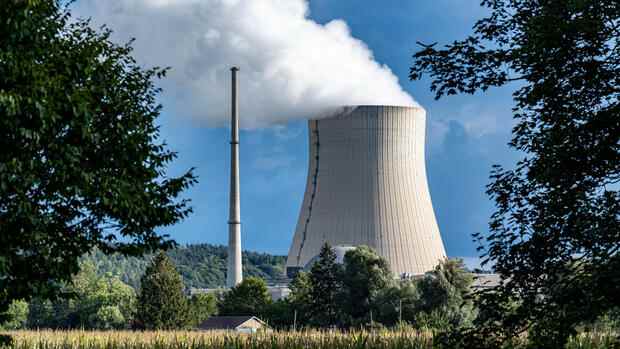A study by the University of Erlangen predicts that longer-running nuclear power plants could reduce the price of electricity by up to 19 percent.
(Photo: dpa)
Berlin High electricity prices are a burden on consumers and the economy. If Germany generates more electricity, the situation could ease. Longer lifetimes of the three remaining nuclear power plants could play a key role in this. This is proven by a study by the University of Erlangen, which was carried out under the direction of Veronika Grimm. The professor is one of the five economic sages.
“Longer maturities have a significant impact on price developments in Germany and neighboring countries,” said Grimm. The positive effects on the CO2 balance should not be underestimated either. “I recommend not to miss any opportunity in this difficult situation.”
If the nuclear phase-out is postponed, the demand for electricity could be covered in a larger number of hours as early as 2024 without fossil power plants. “Very low prices” would be the result, according to the study.
In combination with other measures – such as a strong expansion of renewables and the use of coal-fired power plants, which are actually intended for the shutdown – according to the study, price drops of up to 16 percent are conceivable. If you look at the extension of the nuclear power plant runtime in isolation, the effect is still up to 13 percent, according to the study.
Top jobs of the day
Find the best jobs now and
be notified by email.
This brings the debate about the operating times of the three remaining nuclear power plants in Germany back into focus. According to current legislation, they will go offline on December 31, 2022. However, Federal Minister of Economics Robert Habeck (Greens) wants to allow a “operational reserve” for the Isar 2 and Neckarwestheim 2 nuclear power plants until April 15, 2023. The third plant, the Emsland nuclear power plant in Lower Saxony, is scheduled to go offline at the end of the year.
Two nuclear power plants will remain online in 2023
Isar 2 and Neckarwestheim 2 should only be used when necessary. Habeck recently said that his ministry assumes that the “reserve” will actually be used.
half green
49
percent
This is how large the share of renewable energies in gross electricity consumption in Germany was in the first half of 2022.
The two nuclear power plants are expected to remain online in the first quarter of 2023, he said. The necessary amendment to the Atomic Energy Act was actually supposed to be passed by the federal cabinet on Wednesday of this week, but was removed from the agenda without further explanation.
Within the traffic light coalition, there are different views on the role of the three systems. The FDP wants a longer continued operation. FDP leader Christian Lindner advocates running all three nuclear power plants until 2024. In addition, it must be checked how many of the nuclear power plants that have already been shut down could safely be put back into operation, Lindner said recently.
The study states that the energy crisis is forcing Germany and the EU member states to reassess energy policy decisions and adjust them if necessary. According to the researchers, the price-dampening effects of renewable energies will still be manageable up to 2024.
>> Read also: Which coal-fired power plants will start operating again in October
Even with a strong expansion of wind power and solar, which was announced with the federal government’s Easter package, it would still not be possible in 2024 to meet more than 55 to 60 percent of the electricity demand from renewable energies. In the first half of 2022, the share of renewable energies in gross electricity consumption was around 49 percent according to the Federal Environment Agency.
Coal-fired power plants would have to run longer
The study makes three assumptions for its results: Coal-fired power plants with a total installed capacity of 2.7 gigawatts (GW), which are actually supposed to be shut down in the third and fourth tendering rounds of the coal phase-out law and remain in reserve until March 2024, would have to continue beyond this date keep walking It is also assumed that new fuel rods can be procured for the three remaining nuclear power plants in Germany with a total output of 4.1 GW and that the reactors will remain in operation until the beginning of 2024.
In addition, the study assumes two scenarios for renewable energies: delayed expansion and ambitious expansion. With the ambitious expansion, the researchers expect 45.2 GW of additional capacity in the years 2022 to 2024, and an additional 138.7 GW in the years 2022 to 2027. If the expansion is delayed, the figure is 38.2 GW in the years 2022 to 2024 and 95.2 GW in the years 2022 to 2027.
However, the price effects of extending the service life of the three nuclear power plants are not undisputed. Experts like Felix Matthes from the Öko-Institut say that the electricity price effect for the two southern German nuclear power plants is “extremely small” at 0.5 to 0.8 percent. However, Matthes only refers to a stretching operation of the systems. This means that the piles will continue to be operated with the existing fuel rods for up to three months beyond December 31, 2022, with reduced power generation.
More: Cold withdrawal of Russian gas – Germany is threatened with an emergency winter
